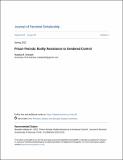Files in this item
Prison periods : bodily resistance to gendered control
Item metadata
| dc.contributor.author | Shwaikh, Malaka M B | |
| dc.date.accessioned | 2022-05-16T12:31:17Z | |
| dc.date.available | 2022-05-16T12:31:17Z | |
| dc.date.issued | 2022-05-10 | |
| dc.identifier | 279549646 | |
| dc.identifier | bb9745db-1ea3-4045-8785-23043bf8c329 | |
| dc.identifier | 000803053800004 | |
| dc.identifier.citation | Shwaikh , M M B 2022 , ' Prison periods : bodily resistance to gendered control ' , Journal of Feminist Scholarship , vol. 20 , no. 20 , 3 , pp. 33-48 . https://doi.org/10.23860/jfs.2022.20.03 | en |
| dc.identifier.issn | 2158-6179 | |
| dc.identifier.uri | https://hdl.handle.net/10023/25376 | |
| dc.description.abstract | Prisons are places of power and resistance. This article is based on original research material derived from Arabic, English, and Hebrew sources, including interviews with menstruating prisoners from Palestine, Northern Ireland, England, and the United States. I document and translate stories, including those of minors who had their first periods behind bars. I then show how several global prison structures fail to provide minimum support, from offering adequate sanitary products to accessing toilets and showers. I also ask what the menstruating body—and its treatment by prison guards and by prisoners—enables us to understand about the gendered realities of detention, and about the possibilities of resistance to those realities. The article argues that masculinization by the prison authorities through mechanisms of shaming and embarrassing of prisoners on periods is a crucial component of gendered control over bodies and spirits in detention. I examine the prison journey from interrogation rooms, court spaces, and prison cells, to the use of prison vehicles to transport prisoners between prisons and to/from courts, and “health care” spaces. I have structured the article around this spatialization to emphasize how gendered control goes beyond one space, and how all spaces illuminate different aspects of gendered control and masculinization. A key contribution in this article can be put as follows: while prisons use menstruation to consolidate gendered control over prisoners’ bodies, prisoners use those same bodies to resist such control not only of the prison authorities in question but also of detention more broadly. I conclude by making a case for prison abolition, paying particular attention to the nuances of prisons in settings of ongoing coloniality and authoritarianism. | |
| dc.format.extent | 16 | |
| dc.format.extent | 413318 | |
| dc.language.iso | eng | |
| dc.relation.ispartof | Journal of Feminist Scholarship | en |
| dc.subject | Prison | en |
| dc.subject | Menstruation | en |
| dc.subject | Period | en |
| dc.subject | Resistance | en |
| dc.subject | Culture | en |
| dc.subject | HN Social history and conditions. Social problems. Social reform | en |
| dc.subject | T-NDAS | en |
| dc.subject | AC | en |
| dc.subject | MCC | en |
| dc.subject.lcc | HN | en |
| dc.title | Prison periods : bodily resistance to gendered control | en |
| dc.type | Journal article | en |
| dc.contributor.institution | University of St Andrews. School of International Relations | en |
| dc.identifier.doi | https://doi.org/10.23860/jfs.2022.20.03 | |
| dc.description.status | Peer reviewed | en |
| dc.identifier.url | https://digitalcommons.uri.edu/jfs/vol20/iss20/3/ | en |
This item appears in the following Collection(s)
Items in the St Andrews Research Repository are protected by copyright, with all rights reserved, unless otherwise indicated.

